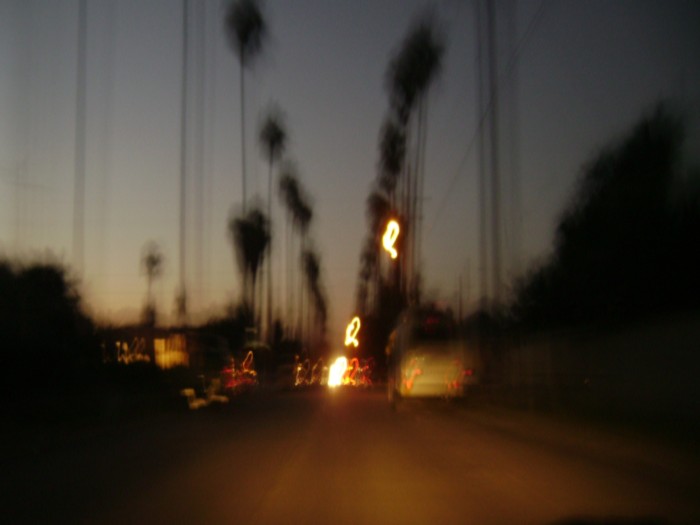Early this year, I wrote another boring confession.
Ronald Ventura: A Thousand Islands
Frank's Pizza
There was a young couple there on the other side of the room, and me on the other side. I actually liked the pizza, and wouldn't hesitate to buy another one with a diet coke, next time I'm in the area.
Fran Lebowitz
Clips of these appearances, however, are not abundant. And of those I've viewed, it's hard to not replay them a few times; these are glimpses of her being interviewed or making a speech in this or that function. Her wit grabs you; it's quite sharp, I think, you end up evaluating your view of certain things in life instantly. And I hope to catch her in person somewhere in New York City, whether she's walking on 5th Avenue, smoking the city around Bryant Park, or just hanging out anywhere in Manhattan. Seeing her would probably feel like an event for me, like I was seeing Picasso, even though Fran's body of work is much lesser than the Spaniard's. But what I'm curious though is her not behind a camera; she seems to know how to project herself through a medium; her facial expressions and hand-gestures complement what comes out of her mouth.
Resting With Calliope
London Riots 2011 & Los Angeles Riots 1992
Boston Globe's The Big Picture section are used.
~
Into the Weekend
Rest Stop
A Blue Duet
Issue twenty-two of Otoliths has just gone live.
Joan Rivers: A Piece of Work
Rivers understands show-business, particularly because of brutalities the ambitious must swallow and endure. And she endured, because she's driven. Workaholism has been her vehicle to success, fame, respect, wealth, and, yes, disrespect as well. For her, work is air, perhaps the only way the lungs of her ambitions can inhale.
I assume she has an over-active imagination, full of ideas, brilliant, bizarre, stupid, or otherwise. And like many successful comedians, who have been through numerous hurdles in show-business, she is smart and calculating. At seventy-five*, it's amazing how energetic this woman is, performing to this and that city, traveling, hungry for something that's not merely money or fame, or even a sense of power, but some sort of fundamental continuity and rhythm in her life, to not fade out of entertaining people.
I'm tempted to say her workaholism is an expression of madness, of trying to control some beast inside her, one that cannot be domesticated, or must be liberated out of its cage through stage performance. And perhaps this is what glamour in show-business is, the liberation of what refuses to be domesticated, into a savage space, the space of spectacle, which, in unequal parts, is: Entertainment, Enlightenment, Farce, and, even Pollution, or simply Air.
[ * Her age when the film was made. ]
Blown
When breezes blow those leaves, that's my gesture I'm taking you with me. Some are green, others brown, or colors that fall between seasons. They fly, rise, give in to gravity, then trashed, after someone's silence gathers them, where echoes of memories flicker like late-afternoon sun-rays filtered through trees.
Breathing Paradise Outside Eden
Kisses
Splendor In The Grass
What though the radiance which was once so bright
Be now for ever taken from my sight,
Though nothing can bring back the hour
Of splendour in the grass, of glory in the flower;
We will grieve not, rather find
Strength in what remains behind;
On the other hand, I'm not quite sure about Warren Beatty's Bud, although he got his share of accolade for his work in this film. And thumbs up, indeed, to Zohra Lampert's Angelina - who only appeared in a few scenes - but played her part well as the woman Bud would eventually marry. There's nice touch in the last part when Angelina is aware about her own clothing, after she meets Deanie who is dressed quite elegantly for Bud but doesn't know that he already has a baby, and another one in the oven. Deanie, too, is aware of her own clothing after meeting Bud's wife. Somehow Deanie realizes she has dressed up for some occasion that doesn't quite belong to what Bud has become, now husband and farmer, what he always wanted to be, ever since, even when his father told him he has to go to Yale. It's as though Deanie realizes that "nothing can bring back the hour [o]f splendour in the grass" with Bud, their years together. It's one of the most painful moments in the film.
Sometimes I wonder if James Dean would've been better for the part of Bud, even though he passed away six years before, in 1955. Marlon Brando would've been good, too, or Monty Clift, but perhaps not Paul Newman. If Beatty and his fans read this, I'm sure they'll get mad. Now this film was Beatty's first as leading man, and already won him a Golden Globe Award, for Most Promising Newcomer, that is; and so, I guess this suggests my assessment of him in this film is incorrect. However, while watching this Eliza Kazan film, I must've been thinking of The Roman Spring of Mrs. Stone, in which Beatty's matinee idol appeal fits perfectly well as a Tennessee Williams protagonist.
The Crying Game
Jessica Hagedorn, Toxicology
Cannes Lars von Trier still win? Lars Von Trier has been Cannes-ed.
Now before Von Trier made those comments, the conference was sailing somewhat smoothly. In some ways, the exchange of questions and answers was lively, peppered with jokes by Von Trier himself. However, there were moments his jokes verged on crossing certain lines, especially those directed to his female cast-members: Kirsten Dunst and Charlotte Gainsbourg. Around the middle of the conference, his jokes about doing a porn-film with these cast-members in his next film-project received shaky laughter. Funny, somewhat funny, mocking, sarcastic, insulting, and, in some ways, sincere. Perhaps this is Danish humor?
Towards the end of the conference, the marriage of those descriptors above gained a less appealing momentum, when Kate Muir from The Times of London asked:
"Can you talk a bit about your German roots, and the gothic aspect of this film? And also, you mentioned in a Danish film magazine also about your interest in the nazi aesthetic, and you talked about that German roots at the same time. Can you tell us a bit/more about that?"A great question, I think. Muir's question was more provocative than the question hurled at this year's competition-jury president, Robert De Niro: "Did you f— my wife?" Had that question been directed to Von Trier, his press conference, no doubt, would've ended with a less depressing note. And so, to answer Muir's question, Von Trier gave a long answer:
But while Von Trier was banned in the festival, his film was not taken out of competition. In fact, it won in the Best Actress category: Kirsten Dunst. In her acceptance speech, after receiving her Prize from Edgar Ramirez, Dunst said:"The only thing I can tell is that I thought I was a Jew for a long time, and was very happy being a Jew. Then later on came Susanne Bier and suddenly I wasn't very happy about being a Jew. No, that was a joke. Sorry. It turned out that I was not a Jew, and even if I'd been a Jew, I would be a kind of a second rate Jew because there are, kind of, a hierarchy in the Jewish population. But anyway, no, I really wanted to be a Jew. And then I found out that I was really a Nazi. Because my family was German, Hartman, which also gave me some pleasure. So I'm kind of a, what can I say? I understand Hitler, but I think he did some wrong things, yes, absolutely! I can see him sitting in his bunker in the end. But there will come a point at the end of this. No, I'm just saying that I think I understand the man. He's not what you would call a good guy, but I understand much about him and I sympathise with him a little bit. No, but come on! I am not for the Second World War! And I'm not against Jews - Susanne Bier? No, not even Susanne Bier, that was also a joke! I'm of course, very much for Jews, no, not too much because Israel is a pain in the ass. But, still, how can I get out of this sentence? No, I just want to say about the art of the, I'm very much for Speer, Speer I liked, Albert Speer I liked. He was also maybe one of God's best children, but he had some talent that was kind of possible for him to use during - OK, I'm a Nazi!"Press Conference for Melancholia, Cannes, 2011;from Wikipedia,
"What a week! My thanks to the Jury, this is a real honour. I'm grateful to the Festival for keeping the film in Competition. And I'm grateful to Lars Von Trier for letting me play the role with such freedom."
Cannes Pedro Almodovar win this time?
Directed by Laurent Cantet, 2005;
Haut et Court/Sévile/France 3/Studio Canal;
108 minutes, French and English
Video-Clip Source: SodaPictures
Coming For Colonialism
Michael Caylo-Baradi
The sex-tourists are not our usual suspects but white women, over 40 and the objects of their desire are young men from Port-au-Prince.
 At the heart of the story is a love-triangle between two of the women tourists and a young man; the “bitch[es] in heat” are Ellen, played by Charlotte Rampling, and Brenda, played by Karen Young. The young man these women are crazy about is played by non-professional actor, Mènothy Cesar as Legba.
At the heart of the story is a love-triangle between two of the women tourists and a young man; the “bitch[es] in heat” are Ellen, played by Charlotte Rampling, and Brenda, played by Karen Young. The young man these women are crazy about is played by non-professional actor, Mènothy Cesar as Legba.To cushion the cat-fights between Ellen and Brenda, Cantet uses the French-Canadian Sue, played by Louise Portal, as occasional referee. Sue seems to know when to move out of the way, when the cat-claws are out, and since Sue has her own young man, Neptune, she safely admires Legba from a distance.
Ellen and Brenda’s rivalry starts to evolve upon the latter’s arrival from Altanta, Georgia, in Petit Anse Resort. At 48, Karen looks slim, somewhat attractive for her age, and ready for a good time; but she had met Legba three years before, when he was 15. It was then that Legba gave Brenda her first orgasm, at the age of 45. Legba, therefore, defines a milestone in Karen’s life as a woman - he is Brenda’s orgasm. Legba bookmarks Brenda’s life, before and after her first orgasm experience.
But now Legba is 18 and the most desired escort among the women tourists. Outspoken and aggressive, Ellen does not hesitate to let Brenda know Legba’s status in the resort: that he is meant to be shared. But the memory of Brenda’s first sexual encounter with Legba heightens her advances towards him. When Ellen realises that Legba responds to these advances, Ellen notices, and foresees complications, because she understands her desire for Legba has found a rival in Brenda.
The competing desire for Legba among these two women is our window into the strength of their characters. Brutal, this clash propels the story; it is the Caribbean “hurricane” or calamity that spins Legba’s fate out of control, even though he projects calm demeanor to save his masculinity from being castrated by hysteria.
Besides being a resort escort, Legba has another life outside the hotel complex. The film reveals that he has relations with other women in Port-au-Prince, especially those from rich families. But his life outside clashes with his life inside the resort. On the day Legba takes Brenda around Port-au-Prince, a four-door Mercedes Benz tries to run him over and then its driver chases him with a gun. Later, when the resort and its patrons have gone to sleep, a Benz dumps two naked, dead bodies in its grounds: one of which is Legba’s. Ellen and Brenda are shocked and confused, that they are not in paradise after all.
After talking to local police about apprehending Legba’s assassins, Ellen talks to the resort’s manager, Albert. A son of resistance fighters, Albert has inherited his parents’ brutal and unapologetic views of white people and when he listens to Ellen, he merely listens as though anything he would say to comfort her is useless because words are inadequate to explain the Haiti that exists beyond the borders of the resort.
Soon, Albert takes Ellen to the airport for her flight back to North America, and home, and she can, at least, anticipate consequences when things happen. But for Karen, the resort is only the first leg of her journey into the Caribbean; the names of the places she wants to visit fascinate her: Cuba, Barbados, Martinique, Trinidad, Bahamas. She seems ready to put Legba behind, although he, no doubt, serves as a reference point for what she expects in Caribbean men, in her sex tours.
Layers of Poverty
Cantet’s realism, in this film, is convincing and can be nauseating; it feasts on the melodramas, pornographies, and dynamics of sex tourism to a point where the facade of tourism disappears and what we see is unapologetic desperation to satisfy basic human needs: food, sex, money, and love. Desire binds these elements together as Haiti: Haiti as state of distress, need, and eroticism. Here, the narrative interrogations of desire take place in familiar terrains that often highlight concerns in post-colonial and neo-colonial social-relations: poverty, labour, and race.
Adoring Adorno & Aesthetic Theory
Now Live: Otoliths 21
EYES CUBE
"The expense of getting a new designer outfit for the Royal Nuptials means there's no money left in the budget to appropriately acknowledge the fact that Otoliths is celebrating its fifth birthday, so we'll just have to let the issue speak for itself, & it does, as elegantly as ever.
Van Nuys, California
Afternoon Sunset
Fran Lebowitz & American Manners
Wanted Cataloger-Historian for Dracula's Archive
I admire the amount of research Kostova had spent for her first novel, which is set in the US, UK, Turkey, Hungary, Bulgaria, Romania, France, or, let's just say, Europe itself. She also offers glimpses of the expansion of the Ottoman Empire, encroaching into the borders of Eastern Europe, where a god-fearing Count -Dracula- tries to defend his territory from being occupied by foreign invaders. This is something new -for me, that is- about Dracula and his connections with Christianity; it almost takes out the evil aspect of vampire identity, an identity I've mainly known through movies and tv-shows, represented in the faces of Christopher Lee, Bela Lugosi, Brad Pitt, Tom Cruise, Antonio Banderas, and Stephenie Meyer's vampire-gang in her Twilight series.
But the other new element that Kostova injects in the mythology of Dracula is that she tries to blur that myth. Here, Dracula is a product of circumstances, that of anger against the expanding Ottoman Empire, of revenge. This revenge reaches a height. That height is myth that quietly morphs into idea, the idea of a highly-intelligent being that can live forever, provided it stays away from sunlight, crosses, garlic, silver-bullets, or wooden-stakes. It's a being that (perhaps) updates the idea of evil in human-form that isn't quite human: vampire: Dracula. Bram Stoker's Dracula is an expression of that update.
Kostova's vision of Dracula in this novel is perhaps the opposite of Bram Stoker's vision of Dracula in his novel. Stoker's Dracula mythologizes a historical figure, Vlad III, Prince of Wallachia (1431–1476), more commonly known as Vlad the Impaler (Romanian: Vlad Țepeș pronounced [ˈvlad ˈt͡sepeʃ]). Kostova de-mythologizes Dracula and treats it as an element of history, a historical-figure whose descendants might still live among us.
Now Live: Galatea Resurrects 16
----------------------------------------------------
Issue No. 16 TABLE OF CONTENTS
[N.B. You can click on highlighted names or titles to go directly to the referenced article.]EDITOR’S INTRODUCTION
Eileen Tabios
NEW REVIEWS
John Herbert Cunningham reviews THE CAMBRIDGE COMPANION TO WALLACE STEVENS edited, and with an introduction by, John N. Serio; WALLACE STEVENS: SELECTED POEMS edited, and with an introduction by, John N. Serio; and WALLACE STEVENS AND THE AESTHETICS OF ABSTRACTION by Edward Ragg
Andrew Durbin reviews THE DIHEDRONS GAZELLE-DIHEDRALS ZOOM by Leslie Scalapino
Allen Bramhall reviews DOGGY DOO by Bob Brueckl & Jukka-Pekka Kervinen
Marthe Reed reviews SONJA SEKULA: GRACE IN A COW’S eye : A MEMOIR : by Kathrin Schaeppi
Eileen Tabios engages SONJA SEKULA: GRACE IN A COW’S eye : A MEMOIR : by Kathrin Schaeppi
Allen Edwin Butt reviews PETALS, EMBLEMS by Lynn Behrendt
Eileen Tabios engages FOR THE ORDINARY ARTIST: SHORT REVIEWS, OCCASIONAL PIECES & MORE by Bill Berkson
T.C. Marshall reviews THE ARAKAKI PERMUTATIONS and WORLDBOOK: 1925—A POEM, both by James Maughn
Nicholas T. Spatafora reviews DAYS POEM, Volume I and Volume II by Allen Bramhall
Peg Duthie engages THE GODDESS OF GOODBYE by James R. Whitley and IGNOBLE TRUTHS by Gail White
Catherine Daly reviews HOW MANY MORE OF THEM ARE YOU? and VICINITIES, both by Lisa Lubasch
Eileen Tabios engages THE NEW POETICS by Mathew Timmons
Caleb Puckett reviews HOW TO BE PERFECT and HOW LONG, both by Ron Padgett
Kimberly Wine reviews CUNTIONARY / REPENT AT YOUR LEISURE (OR THE FOLKLORE OF HELL) by Benjamin Perez
Nicholas T. Spatafora reviews THE CHAINED HAY(NA)KU PROJECT curated by Ivy Alvarez, John Bloomberg-Rissman, Ernesto Priego and Eileen Tabios
Andrew Durbin reviews THIS TIME WE ARE BOTH by Clark Coolidge
T.C. Marshall reviews OPENING DAY and THE WHALEN POEM, both by William Corbett
Harry Thorne reviews THE ECO LANGUAGE READER edited by Brenda Iijima and IF NOT METAMORPHIC by Brenda Iijima
Tom Beckett reviews IF NOT METAMORPHIC by Brenda Iijima
Eileen Tabios engages 100 SCENES by Tim Gaze
Simon Perchik reviews CREATURELY DRIFT, NEW AND SELECTED POEMS by Allen Planz; EROS DESCENDING, POEMS by Edward Butscher; THE DISCOURSE LETTERS by Anselm Parlatore; THAT NOD TOWARD LOVE, NEW POEMS by Graham Everett; SILVER FISH, POEMS by Ray Freed; SHARPSBURG by Joel Chace; and BLUE EDGE by Susan Tepper
Allen Edwin Butt reviews TERMINAL HUMMING by K. Lorraine Graham
Micah Cavaleri reviews ENGLISH FRAGMENTS: A BRIEF HISTORY OF THE SOUL by Martin Corless-Smith
Jessica Bozek reviews SUM OF EVERY LOST SHIP by Allison Titus
John Bloomberg-Rissman reviews NOTES ON CONCEPTUALISMS by Vanessa Place and Robert Fitterman
Eileen Tabios engages THE SOURCE by Noah Eli Gordon; THUS & by Derek Henderson; and DOG EAR by Erica Baum
Tammi McCune reviews ITERATION NETS by Karla Kelsey
Jim McCrary reviews PITCH – DRAFTS 77-95 by Rachel Blau DuPlessis and DAY OUT OF DAYS (STORIES) by Sam Shepard
Jonathan Lohr reviews DUTIES OF AN ENGLISH FOREIGN SECRETARY by Macgregor Card
Steven Johannes Fowler reviews IN THE ASSARTS by Jeff Hilson
Peg Duthie engages THE BOOK OF WHISPERING IN THE PROJECTION BOOK by Joshua Marie Wilkinson
Guillermo Parra reviews YOU AND THREE OTHERS ARE APPROACHING A LAKE by Anna Moschovakis
Eileen Tabios engages X (ANGEL CITY) by Joseph Lease
Steven Johannes Fowler reviews CLERICAL WORK by Wayne Clements
Genevieve Kaplan reviews VENTRAKL by Christian Hawkey
Crag Hill reviews AD FINITUM by P. Inman
Eileen Tabios engages BONE BOUQUET: A JOURNAL OF POETRY BY WOMEN, Vol. 1, Issue 1, Winter 2011
Jerry Brunoe reviews A THIRST THAT'S PARTLY MINE by Liz Ahl
John Herbert Cunningham reviews THE SELECTED POEMS OF TED BERRIGAN edited by Alice Notley, Anselm Berrigan and Edmund Berrigan
Jim Tolan reviews AS IF FREE by Burt Kimmelman
Fiona Sze-Lorrain reviews AIRS & VOICES by Paula Bonnel
Eileen Tabios engages THE HISTORY OF VIOLETS by Marosa Di Giorgio, Trans. By Jeannine Marie Pitas
T.C. Marshall reviews ARRANGING THE BLAZE and PARABLE OF HIDE AND SEEK, both by Chad Sweeney
Bill Scalia reviews THE PACKAGE INSERT OF SORROWS by Angela Genusa
Micah Cavaleri reviews SCENIC FENCES | HOUSES INNUMERABLE by Aby Kaupang
Michael Boughn engages the article "THE HERO AND THE GUNSLINGER: DID ROBERT CREELEY AND ED DORN LOSE THEIR WAY IN MIDDLE AGE?" by Aram Saroyan
Marianne Villanueva reviews SONNETS by Camille Martin
Eileen Tabios engages NOVALESS (ELEMENTS TOWARDS A METAPHYSICS) by Nicholas Manning
Jerry Brunoe reviews ISHMAEL AMONG THE BUSHES by William Allegrezza
Jeff Harrison engages COMPLICATIONS by Garrett Caples
G. Justin Hulog reviews DIWATA by Barbara Jane Reyes
Aileen Ibardaloza engages BABAYLAN: AN ANTHOLOGY OF FILIPINA AND FILIPINA AMERICAN WRITERS, co-edited by Nick Carbo and Eileen Tabios and THE NORTON ANTHOLOGY OF LITERATURE BY WOMEN: THE TRADITIONS IN ENGLISH, Third Edition, volume 2, co-edited by Sandra M. Gilbert and Susan Gubar
Eileen Tabios engages CHAPTER & VERSE: POEMS OF JEWISH IDENTITY edited by Sim Warkov, Rose Black, Margaret Kaufman, Melanie Maier & Susan Terris, and BLOOD HONEY by Chana Bloch
FEATURE ARTICLES
The Quincouplet: a Matter of Words
by Benjamin C. Krause
Kingdom by the Harbor by Nicholas T. Spatafora
THE CRITICS WRITE POEMS
Marthe Reed
Simon Perchik
FROM OFFLINE TO ONLINE: REPRINTED REVIEWS
Moira Richards reviews CARRYING THE FIRE and BURNT OFFERING, both by Joan Metelerkamp
Richard Kostelanetz reviews the article "Re: Print: Poems from Ten Exciting New Books,"
ADVERTISEMENTS
Hay(na)ku for Haiti--a Haiti Relief Fundraiser
Poets On Adoption:
Poetry: it inevitably relates to -- among others -- identity, history, culture, class, race, community, economics, politics, power, loss, health, desire, regret, language, form and genre disruption, love ... as well as the absences thereofs. The same may be said about Adoption."
BACK COVER
Let Sleeping Dogs Lie...
Decelerating Infinity
Decaffeinated Fame: Lady Gaga
Pleasure to Ruin
On The Road
Dinaw Mengestu
More Fables
Clothing
Stars
Awesome Physics Talks
Description For A Car
Products
Mike Tyson
(For interested parties: video section of paper's website.)
Ian McEwan & Richard Dawkins - On Moral Instincts, Religion, Atheism, Love, Darwin, Inward Cinemas.
What is ironic about the way or tone Dawkins promotes his ideas regarding atheism and evolution is that he often sounds eerily dogmatic you think he's about to start his own religion, a fourth and official addition to the eternal triumvirate: Christianity, Islam, and Judaism.
Righting Frames Left

I am on the left-turn pocket, about to make a left. The wait hair-splits seconds to infinity, a very physical experience of eternity on a street-intersection, the kind in which your life feels trapped, and there is only one direction, there, into the abyss of the left, into its freedoms, chaos. I see faces in the cars, on the other direction, faces of pursuit, aggression, those who'd confess their day in frantic phone calls later, unnecessary calls they have to make just to have someone to talk to, to feel linked, networked. They are wearing sunglasses, as though to leave the sun out of their directions, ignore its illuminations, consider them distractions, nuisance. I am in the intersection of 5:00pm and 5:01pm, the intersection of life as abstract and life as material, bad decisions and worst decisions, fiction and non-fiction, poetry and reality. In a moment, I could crash, collide into another dream in the making, a city official, a president of a porn-company, a thief trying to be the best thief in the world, or a horny man having phone sex on his cell-phone. My life is on the line, and there are no lines to read in-between those lines. Am I in someone's surveillance camera? Am I in a movie-production set? I make the sign of the cross. Soon, I let that sign fade to insignificance, to the shadows of other crosses I've made before. The light is green, is yellow, is red, the color of anything, an empty sign, emptied of sunsets, death, crime, failure, genesis of ironies, the erotics of daily life, birth, or as myth before flights to nowhere.
Reroute
I roll down the windows, for the wind to blow your mind in mine.
One Way
@ Calliope Nerve
for publishing my poem at Calliope Nerve.
by Nobius Black with Make It New Media, LLC.
Galatea Resurrects 15
Reviewers & Contributors
Aileen Ibardaloza
Albert B. Casuga
Allen Bramhall
Anny Ballardini
Barbara Roether
Camille Martin
Edric Mesmer
Eileen Tabios
Eric Dickey
Eric Hoffman
G.E. Schwartz
Genevieve Kaplan
Hadas Yatom-Schwartz
Harry Thorne
Jeff Harrison
Jim McCrary
John Bloomberg-Rissman
John Herbert Cunningham
Jon Curley
Kathryn K. Stevenson
Kristi Castro
Kristina Marie Darling
L.M. Freer
Lisa Bower
Lynn Behrendt
Margaret H. Johnson
Marianne Villanueva
Michael Caylo-Baradi
Michael Pollock
Moira Richards
Nicholas T. Spatafora
Patrick James Dunagan
Peg Duthie
Rebecca Loudon
Richard Lopez
T.C. Marshall
Thomas Fink
Tom Beckett


























